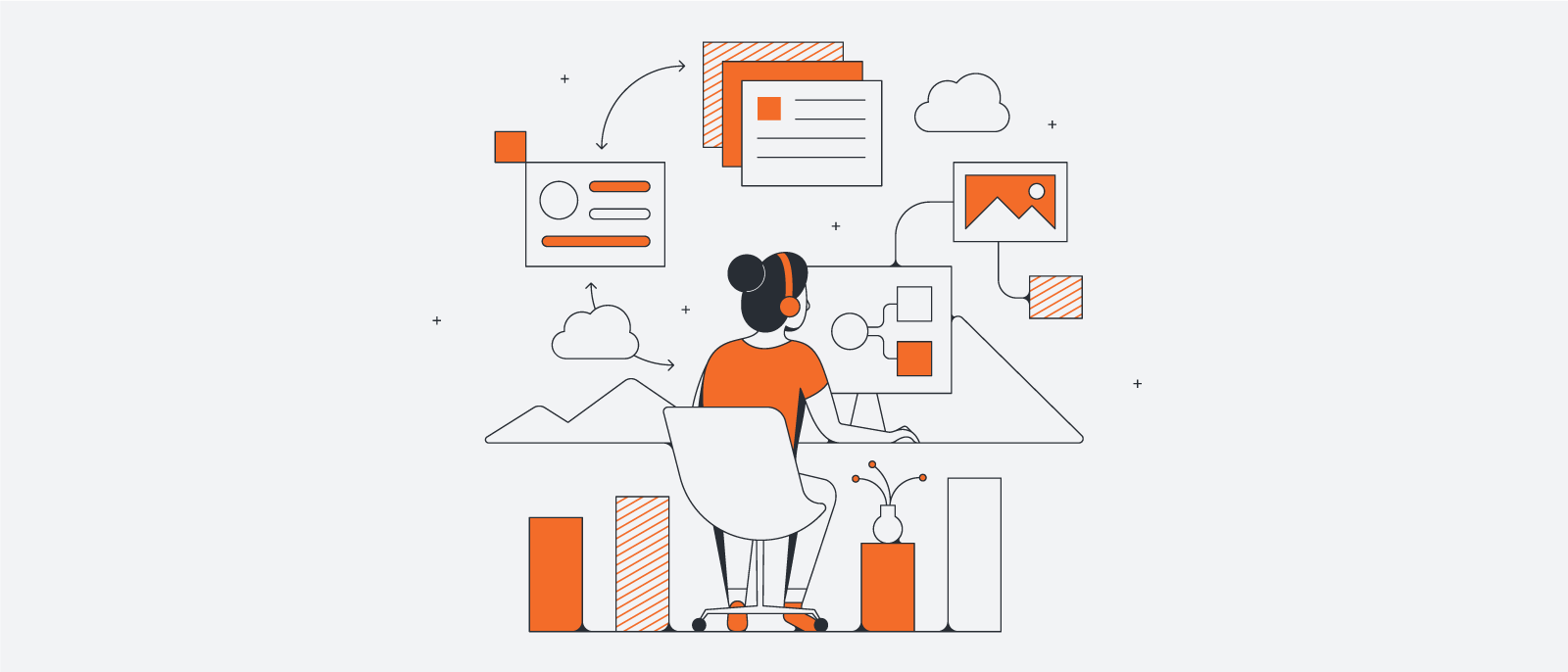
Documenting processes for hybrid teams
Reading time: about 7 min
Every business has processes that are essential for getting things done. How well the processes are defined and how closely the employees adhere to them can determine how successful the business is. And it’s important that new employees learn a company’s processes quickly so work can continue to run smoothly and consistently.
Many companies rely on existing employees to show the new employees how things are done. This sometimes works well, but typically depends on the employees all working at the same location to learn in-person.
But if you have hybrid teams with some employees working remotely while others work in the office, it’s not as easy to transfer knowledge verbally or through hands-on training. To make sure that employees know what is expected and to keep everybody on the same page, it’s vital that you capture your company’s process information in well-written and detailed documentation.
Why is process documentation important?
It’s great when your employees know their jobs and current processes well enough so they can pass that information to new employees. But companies need to be prepared if their experts aren’t always available.
For example, if you only have one person with knowledge of a specific process and nobody else has been trained on that job, what do you do when that person goes on vacation or gets another job? If processes are meticulously documented, you’ll have a good base to help somebody else step in and take over quickly.
According to a 2016 BPTrends Report, about 53% of companies never, or only occasionally, document their processes. Another 43% report that they document processes frequently or most of the time. Shockingly, only 4% said that they always document their processes.
There are plenty of reasons that organizations might not document their processes—not knowing where to start, not wanting to spend the time or effort, thinking they just don’t matter—but there are far more benefits than drawbacks.
In addition to providing detailed documentation, you should also make it a practice to ensure that more than one employee knows how to perform mission critical tasks. That way, you are double-covered when your knowledgeable employee leaves because you have someone who can step in and do the job, and you have a reliable set of documentation as your backup.
Benefits of process documentation
If it hasn’t been a practice to document your processes, you might find it difficult to get started. But it’s worth it! Some of the benefits of process documentation include:
- Operational redundancy: Documentation reduces the risk of losing institutional knowledge when key talent leaves the company.
- Operational consistency and compliance: Documentation becomes a single source of truth for consistent operation, quality, and compliance with industry standards and regulations.
- Increased efficiency: Consistency leads to better efficiency and cost reductions.
- Improved business processes: The documentation becomes your reference point for studying facts about your current processes so you can make informed recommendations for improvements.
- Train new employees faster: Written processes help new employees come up to speed more quickly and can fill in any gaps that they don’t remember from the training.
- Analyze and compare current processes more easily: Analysis and comparison lets you calculate efficiencies, costs, and other important metrics for your processes.
- Fewer defects and higher quality: Employees who stick to the precise steps outlined in the documentation will experience fewer defects while releasing higher-quality products.
What are some challenges of process documentation?
As your company grows, it’s going to get more complex. And as your business operations get more complex, there are new challenges related to documenting processes.
Hoarding knowledge
It can be difficult to gather information you need to document processes, especially if some people are reluctant to share knowledge. Some employees don’t share knowledge about their jobs because they feel like it gives them more job security.
But, transparency and sharing information actually builds more trust, a stronger work culture, and encourages more engagement. Sharing information raises morale, encourages teamwork, and increases overall efficiency. Transparency and open communication is key to managing a successful, happy, and productive hybrid team.
Feeling self-conscious
Sometimes people will change the way they do things because it “works” for them. But if they are reluctant to tell anybody or document these changes, it could cause problems with processes later as more people join the team, and as the team grows more geographically diverse.
When a team member finds a better way to do something, it’s important to share and document that information to keep everybody on the same page. Your people shouldn’t feel like they need to hide any changes they make to the process.
Expecting the documentation to be perfect
If you have not been documenting everything from the beginning, starting now when your company is growing and spreading across multiple locations can seem daunting. Don’t think that your documentation has to be perfect from the start. Start with smaller, easier to complete tasks so you can figure out your process for process documentation. As you get more familiar with your documentation process, you will feel more comfortable tackling some of your more complex business processes.
Lacking faith in the documentation
While your process documentation doesn’t need to be perfect from the start, it still needs to be accurate. Some of your remote team members might rely exclusively on the documentation to learn processes. It can be really frustrating if steps are incomplete or poorly written. Employees will stay away from the documentation if the perception is that it’s incorrect. You need to create and promote accurate, dependable documentation.
How to document a process step by step
It’s more than just sitting at the keyboard and writing a series of steps. Your documentation will be better and more complete if you take some time to think about what should go into it and where you will get process information.
As with any process, these steps are not set in stone. These are only suggestions to help you get started. You will define and modify your documentation process as you go.
Step 1: Identify the process
Determine which process you want to document. Define its purpose, how it benefits your organization, and how it aligns with corporate goals.
Step 2: Define the scope
Provide a brief description of the process. Determine what is in the process and what is not in the process. Define the process starting and ending points.
Step 3: Define your audience
Understand who will be using this documentation. What do they need to know? Don’t use acronyms excessively because new employees might not be familiar with them. Be detailed enough that the average person can complete the process whether they are new to the company or have been there a while.
Step 4: Identify individual roles
Some processes involve more than one person. Document who does what in the process.
Step 5: Gather information
Talk to people familiar with the process to document every step. Collaborate with others to determine the most important steps needed to complete the process.
Step 6: Organize the information
Arrange the information you gathered into an outline to use as a guide when you write the process steps.
Step 7: Write the process
Turn your outline into detailed steps. Keep the documentation clear and concise.
Step 8: Make it visual
Our brains process images faster than text. Visual aids like flowcharts, wire frames, and illustrations can help your audience to understand the process more quickly.
Lucidchart can help you with ideas for adding visuals to your process documentation. Try out the process flow template below.

Want to see how visual documentation helps users? Read more about the benefits.
Take me there
Step 9: Get feedback and revise
Have some people who are not familiar with the process try to complete the process using only your documentation. This will give you valuable information about what works well and what needs to be revised.
Step 10: Release the documentation
Make sure that everybody who needs the documentation has access to it. Be sure to keep it in a central location so you don’t end up with multiple copies. It’s too difficult to manage and update multiple copies of the documentation later when processes are revised.
Step 11: Revisit as needed
Your process documentation is complete for the moment. But, it’s inevitable that your processes will be improved and your documentation will need to be revised. Plan to check the documentation against the process periodically to see what might need to be updated.

Ready to dive even deeper into business process design? Check out these tips from Alec Sharp, senior consultant at Clariteq.
Read the tips hereAbout Lucidchart
Lucidchart, a cloud-based intelligent diagramming application, is a core component of Lucid Software's Visual Collaboration Suite. This intuitive, cloud-based solution empowers teams to collaborate in real-time to build flowcharts, mockups, UML diagrams, customer journey maps, and more. Lucidchart propels teams forward to build the future faster. Lucid is proud to serve top businesses around the world, including customers such as Google, GE, and NBC Universal, and 99% of the Fortune 500. Lucid partners with industry leaders, including Google, Atlassian, and Microsoft. Since its founding, Lucid has received numerous awards for its products, business, and workplace culture. For more information, visit lucidchart.com.
